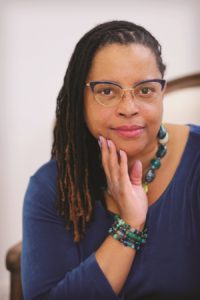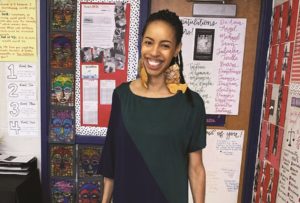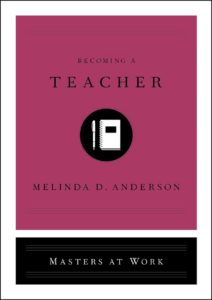What is the likely career trajectory of an inventive, gifted Teacher of the Year who is passionate about racial and social justice and who works in an urban public school? Choose one: (A) department chair; (B) principal; (C) district administrator. Quitting probably wasn’t on your list, either. And yet, quitting is exactly what LaQuisha Hall did this past summer.

Hall is the teacher Melinda D. Anderson chose to profile in Becoming a Teacher, her superb contribution to Simon & Schuster’s Masters at Work series. Anderson explains that Hall was named Baltimore City Public Schools Teacher of the Year in 2018-2019. At the time, she was the first African-American teacher to be recognized in five years in a district where more than 80 percent of students are black and in a high school, Carver Vocational Technical, whose population is all black.
Hall, who is from North Carolina, entered the profession at 21 in 2003. She was poised to attend a Christian law school in Virginia when she moved to Maryland to earn a tuition-free master’s degree in education in exchange for five years working as a teacher. Getting an advanced degree for free and working for pay seemed like a better opportunity to Hall than going to law school. Though it was difficult to enter a middle-school classroom without any experience, Hall managed, drawing on her talents as an artist, pageant winner, life coach, and survivor of childhood sexual abuse. Finding an older, supportive teacher to mentor her was also critically important to her success.
Over the course of 17 years, Hall developed classroom strategies so that she could teach in ways that made sense to her and her students. She decided to tackle freshman English at Carver, which allowed her to avoid preparing students to take an annual standardized skills test. When she realized that her students were turned off by the district’s curriculum, she ditched it and had students choose a book from classroom bins she had filled with works they would find relevant, including young adult novels written by black authors. Anderson provides ample evidence and anecdotes demonstrating Hall’s delight in connecting academically and emotionally with students, who clearly respected and enjoyed being in her classes. With patience, humor, and forgiveness, Hall got students writing as well as reading. She self-published an anthology of student writing and worked to change perceptions of young teens of color.

Even as she showcases Hall’s many virtues in Becoming a Teacher, Anderson makes clear the obstacles that most teachers encounter. She promises in her introduction that she will tell “the story of one master teacher,” and thereby show readers “the nitty-gritty of the profession” while exploring “the enormous, messy, and complex system of American public schooling.” That “nitty-gritty” includes qualifying exams that often prevent teachers of color from pursuing the profession, low pay, high stress, endemic burnout, lack of respect from parents and politicians, rigid curricula equating student test scores with mastery, heaps of administrative paperwork, crumbling facilities, supply shortages, inequities in funding between urban and suburban districts, and a lack of diversity among teaching staff. Anderson explains that these and other problems lead half of all new teachers to quit in their first five years on the job. The numbers are even higher among teachers of color. And yet, Anderson writes, having a teacher of color is one of the most important variables leading students of color to complete high school and go to college.
Both Anderson and Hall confirmed independently that, early on, they had discussed the possibility that Hall would leave full-time teaching. Anderson edited the last chapter just before publication to reflect Hall’s decision. Hall can be found on Instagram @mrshallscholars. She has more than 10,000 followers. She reports that she continues to find ways to coach other teachers, especially in areas related to language and literacy.
Given Hall’s departure from the classroom, it’s tempting to see the book as more about leaving than becoming a teacher. It’s to editor Stuart Roberts’s credit that he and Anderson did not feel compelled to sugarcoat the profession and that he kept the book in the Masters at Work series, which will ultimately include about 30 titles. Roberts explained to me that the goal of each book is to introduce a variety of jobs to young people considering careers and also to older people thinking about transitioning to new work. Other professions covered in this nifty series range from neurosurgeon to hairstylist, venture capitalist to crime scene investigator.
“I am so, so proud of Becoming a Teacher,” Roberts said. “It’s important.” He is especially pleased with the ways that Anderson homed in on “bigger issues of identity and equity in education.”

In some ways, Hall’s decision is no surprise, given all that Anderson explains about the difficulties of the profession. But in other ways, Hall’s choice — which Anderson reveals on the second-to-last page of the book — is a stunner. “Effective teaching, like all professions, is a fusion of talents and competencies,” Anderson writes, “among them exceptional oral and verbal communication skills; attentiveness to others’ needs; unending patience and resourcefulness; stellar organization and time management; and a reservoir of motivation.” LaQuisha Hall ticks every box.
Read Becoming a Teacher to appreciate the gifts fine teachers offer their students and, perhaps, to be inspired to give the profession a go. Read Becoming a Teacher as a primer to understand the crisis in American public schooling, elements in place well before Hall made her decision to quit and before Covid struck. Most of all, read Anderson’s vivid portrait to fathom the depth of the loss when such an extraordinary teacher decides to leave her classroom — for her students, for her school, and for us as a nation.



